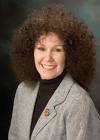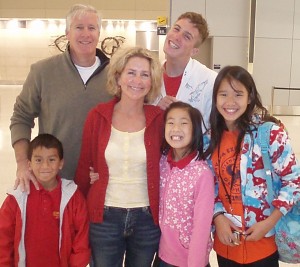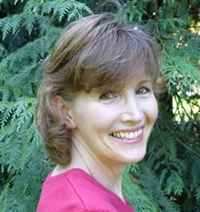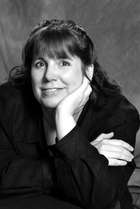
Markus Zusak
Markus Zusak is a storyteller. Whether standing in front of a group that’s come to hear him speak or writing the words to a book, he has the uncanny ability to weave a story that keeps people on the edges of their seats until the very end. Part of Zusak’s appeal is his ability to be so down-to-earth and humble in the face of the enormous popularity of his most recent work, The Book Thief.
My daughter, Madeleine, and I had the wonderful opportunity to experience Zusak’s charm in person when I interviewed him before a bookstore appearance in Portland, where he stopped over on a tour to promote the release of The Book Thief in paperback. Zusak was generous with his time, and we were able to talk about writing in general as well as specifics about two of his works, I Am the Messenger and The Book Thief. (From a November 2007 interview.)
How did you know you wanted to be a writer?
MZ: I read some books that were the right books for me. I read them and I didn’t even notice turning the pages anymore. I thought, “That’s what I want to do with my life.” There are two magic acts I want to pull off when I write. One is creating a feeling that when you’re inside a book, you believe everything you’re reading even when you know it’s not true. And the second is an extension of that, which is you know it’s not true, you know it’s not real, but you believe it anyway. And it’s that believing of the story that isn’t real that attracted me to writing and storytelling in general.
I was sixteen when I tried to write my first book. And it could easily be entered into a competition for the worst book ever written. I only wrote eight pages. That’s what happens every time I write a book now. I write eight pages that aren’t very good at all. Then I go through it the next time and the next time, pull the gems out and start again.
Do you read very much?
MZ: It’s insane to be a writer and not be a reader. When I’m writing I’m more likely to be reading four or five books at once, just in bits and pieces rather than subjecting myself to a really brilliant book and thinking, “Well what’s the point of me writing anything?” I’m more likely to read a book through when I take a break from writing.
Do you have any favorites?
MZ: What’s Eating Gilbert Grape (by Peter Hedges). That’s a real favorite, because I really love character. I also like Catch-22 (Joseph Heller). When I was first shown the book I was sixteen and I couldn’t get into it. I picked it up again and read it later on. But I was at least exposed to the book at school.
The Book Thief was written from an angle that you rarely see, that of ordinary German people living under the Nazi regime. Why did you choose to write that story?
MZ: There are a few reasons, but the main one is that those are the stories I knew. My mom is German my father is Austrian. I grew up hearing those stories. One of my mum’s stories was about something that happened when she was six. She heard a noise that sounded like cattle being herded down the street. It was people being herded to a concentration camp. There was an old man who couldn’t keep up, and a boy gave him a piece of bread. They were both whipped, one for giving the bread, one for taking it. When you see a soldier chase a boy down and beat him to the ground for being kind to somebody, when you see that when you’re six, what could you possibly make of that?
You don’t really think of humor when you think of that time, but there were a lot of funny stories as well. I knew about my dad “jigging” as we say in Australia the Hitler Youth meetings, because he had a friend who suffered at the hands of the leaders. So they just said, “We’re not going. We’re going to go to the river instead and get dirty enough to fool our parents.” Another story I knew was about Hitler’s birthday, and my mother’s foster father refused to fly the Nazi flag. His wife said to him, “You’re going to fly the flag or else they’re going to come for us.” These are the stories I knew, and I thought, “I haven’t seen that on all the documentaries. I’m going to use these because this hasn’t necessarily been done a lot.”
Did you think of this as a book about the Holocaust?
MZ: I never thought of this as a Holocaust book, ever. When you think of World War II and what happened in Germany, you immediately think Holocaust and concentration camps. Once I started researching I kept uncovering more and more things like the beautiful acts that some Germans did such as hiding their Jewish friends in their basements. And the more I’d see of this the bigger the book got and instead of a 100 page novella that I was thinking about, I ended up with a 580 page book. All my books are important to me, but this is the one that is everything to me because of where it came from.
How did you decide to use Death as the narrator?
MZ: The decision to use Death as a narrator only came off the second time around; if I had stuck to publishing deadlines Liesel would probably be the narrator. I went from Death as narrator to Liesel telling the story herself to even trying third person. The real breakthrough was when I thought of the last line of the book. I was in down in Tasmania and there was water everywhere around me. I was reminded of the last line of a book called “A River Runs Through It,” which is, “I am haunted by waters.” I thought, “Aaaahhh, Death is afraid of us and haunted by us, because he is on hand to see all the terrible things we do to each other. It makes sense that he is telling the story to prove to himself that humans can be beautiful and selfless as well.”
How did you conduct your research?
MZ: To begin I interviewed my parents, did some reading and then started writing. So I had a base of the story, then I’d do more research and I’d do more writing. I finished the manuscript and then I went to Germany to check everything. And I didn’t really have to change anything. A few new things came up, but on the whole everything was pretty much right. That world of Germany was in my head the way English is in my head, because of the stories I heard growing up. It was like I could reach for it the same way I can reach for a word to use. I researched to pick up the little things. I don’t want Orville from the south Australia apple growers association writing to me saying, “You know those apples they stole in part three, that wouldn’t have been right, because they wouldn’t have been ripe.” These things are important, because you want to write with integrity.
Is there anything that surprised you in the research?
MZ: When I find research really rewarding is when one piece of information gives you an idea for a story. That’s when it’s great. Not just to show what you know. Like when the kids play ball in the street I thought, “I’m going to try to find football players or soccer players from that time that they may have idolized.” I walked into the library and just lying there was a book on the Olympics. I saw this picture of Jesse Owens, and I thought, “I don’t need any more; I’ve got Jesse Owens.” And the very moment that Rudy paints himself black with charcoal and becomes Jesse Owens he becomes my favorite character and the one I cried for the most when I was writing the ending. I deliberately wrote that he was going to die earlier that he did to prepare the reader and myself for writing that at the end. Also everything Rudy does after that moment, when you know he’s going to die at the age of 14, everything is in the shadow of that.
Did you find it difficult to find the voice for a young female character?
MZ: That was why I used Death as the narrator, because when I had Liesel writing the book she was the most Australian sounding German girl in the history of writing. The voice of Liesel definitely does come through though, and you see things from her point of view.
I was curious about the special relationship between Liesel and Hans. It’s unusual to have the father as the emotional support in a household while the mother is unapproachable. Why did you create the relationship that way?
MZ: That was the experience of my mother’s childhood. Hans is a cross between my mother’s foster father and my father’s father. Some of the things that happened to him actually happened to my grandmother on my dad’s side. I didn’t even consider doing it another way.
Have your parents read the book?
MZ: My parents became insufferable while I was writing the book, because it kept getting longer and longer. They kept asking, “When’s the book going to be finished?” Finally I just had to banish the discussion. Now, my mum’s read the book three times. She’s listened to the audio as well. When my dad read it he swore at me and said, “You made me cry.” I couldn’t say anything but thank you.
I was struck by your interesting use of metaphor relating colors to sounds.
MZ: I think it was particularly appropriate for this book. Death was almost breathing colors in to distract himself from all the misery that surrounds him. That in a way was a metaphor for the idea that this book is about people doing beautiful things in a really ugly time. And that’s what Death is trying to seek out.
The Book Thief was released in Australia for an adult audience, but in the U.S. it’s been promoted as a young adult book. What type of reader were you thinking of when you were writing?
MZ: I thought no one would read this; I thought it would be my least read book by a mile. You think about a book set in Nazi Germany and it’s 500 pages long and you write about Death and everyone dies. It’s not exactly a book you recommend to your friends, especially if they’ve had a bad day. I look back and realize that I forgot the audience as I was writing. What I wanted to do, what I’ve always wanted to do was write someone’s favorite book. I’m aiming for that top shelf when I write, and it doesn’t matter if it’s in the kid’s section or the biography section or whatever. It’s more ambitious than writing a young adult book or an adult book. People know when your heart is in a book, and I think people can tell that my heart is in this book more so than any of my other books.
If you didn’t think anyone was going to read it, it must be quite a surprise that it’s been translated into several different languages and been on the bestseller list in several different countries. How does that feel?
MZ: It still astonishes me. It’s really ridiculous in a sweet way when people line up to get the book signed and they want to get a photo. The fact that there are people who really want to read this book and have loved it is really humbling and makes me want to write a better book next time. People say to me, “Don’t put so much pressure on yourself; you don’t have to write a better book. It just has to be a different book.“ And I say, “Every time I wrote a book previously I thought I had to write a better book so why not this time as well?”
Let’s talk for a minute about I Am the Messenger, which is very different from The Book Thief. It’s set in Australia and features a group of young people just starting out on their own. Did you put something of yourself into the main character, Ed?
MZ: It’s unavoidable I guess when you write anything. There’s probably a piece of me in Liesel and a piece of me in Death. If you look at Ed or even at Cameron Wolfe, the protagonist of my first two books, there’s definitely a lot of me in them. I think I was a lot like Ed. I lacked confidence severely for a long time, and that was a fundamental part of Ed’s character. Underneath it all I wanted Ed to be like a superhero, but without superhero powers. I think that’s when you find out who you really are. What if you had to do amazing things and you had to reach into your humanness for that? That’s what Ed is doing in that book.
Again, your idea for the premise of the book seems so out of the ordinary. How did you come up with the idea for I Am the Messenger?
MZ: That was a simple thing. My wife gave me the idea. We were eating fish and chips in the park, and we looked across the road and saw a bank. Outside the bank was a 15-minute parking zone. We both knew that it usually takes a lot longer than that when you’re in the bank. And my wife said to me, “What if you were in that bank and it’s getting robbed and your car is in a 15-minute parking zone. How would you get out to move your car?” That first chapter came out of that, and it was one of the easiest things I’ve ever written.
I often ask two questions when I’m writing. One is, What is the worst thing that can happen?” The other is, “What is the unexpected thing?” From a bank robber’s point of view, the worst thing that can happen is that the police show up. The unexpected thing is that they don’t come in the bank. They get the double-parked car at the bakery across the road to move on, and then all of a sudden that’s the next problem, because that was his get-away car. The very thing that saves him is his next problem.
What are you working on now?
MZ: I’m working on a book called Bridge of Clay. This is the book I’ve always wanted to write. It’s about a boy building a bridge. His name is Clay. There’s the idea of clay being something you can mold into anything, but it needs to be set with fire. There’s a unique structure again.








